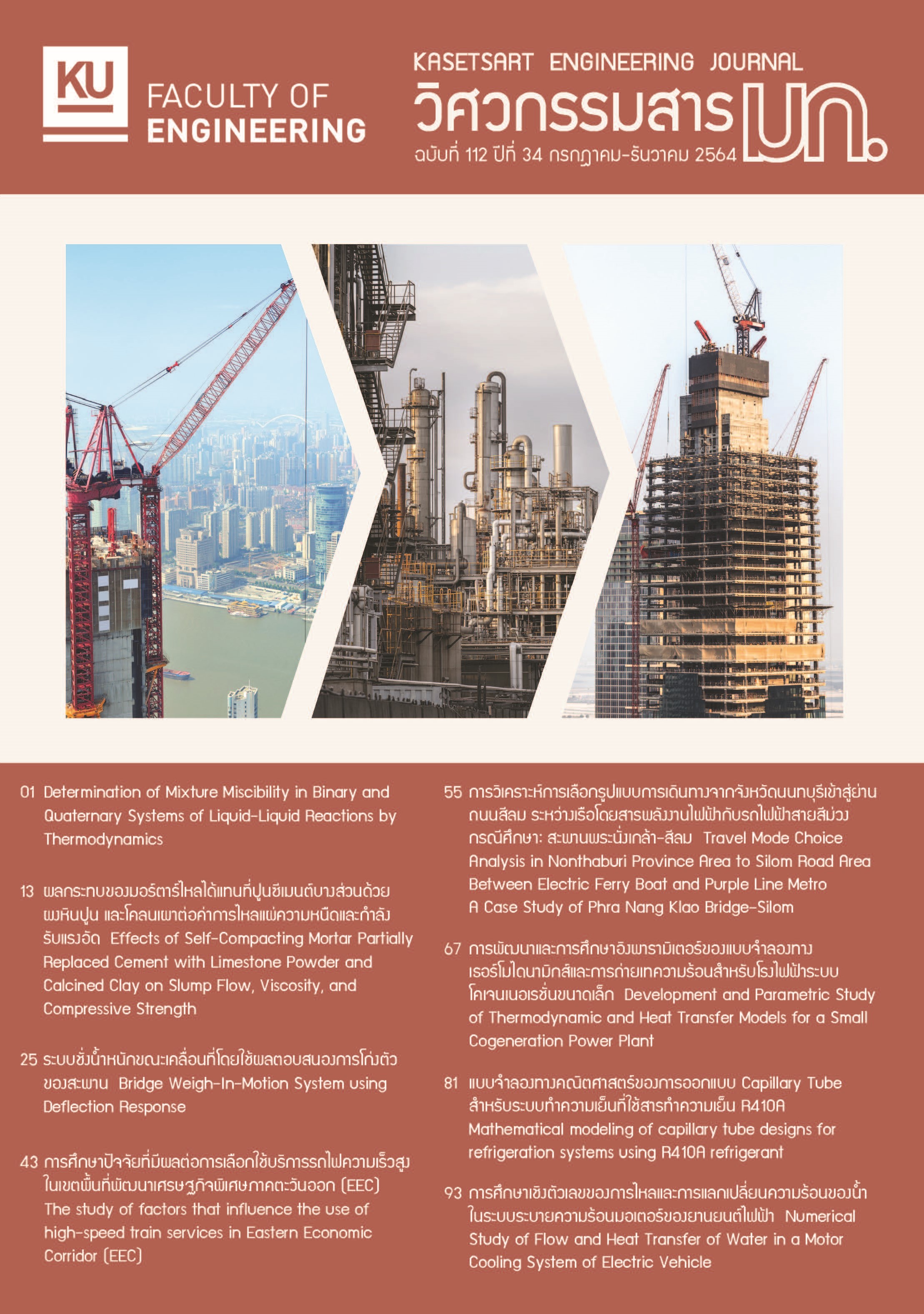การพัฒนาและการศึกษาอิงพารามิเตอร์ของแบบจำลองทางเธอร์โมไดนามิกส์และ การแลกเปลี่ยนความร้อนสำหรับโรงไฟฟ้าระบบโคเจนเนเรชั่นขนาดเล็ก
คำสำคัญ:
การศึกษาอิงพารามิเตอร์, ประสิทธิภาพโคเจนเนอเรชั่น, ความสามารถในการใช้พลังงานปฐมภูมิในกระบวนการผลิตพลังงานไฟฟ้าและพลังงานความร้อนบทคัดย่อ
โคเจนเนอเรชั่นเป็นเทคโนโลยีประสิทธิภาพสูงและประกอบด้วยกังหันก๊าซ กังหันไอน้ำ และเครื่องผลิตไอน้ำจากไอเสีย ในการศึกษาวิจัยเป็นการพัฒนาและการหาค่าที่เหมาะสมของแบบจำลองโรงไฟฟ้าระบบโคเจนเนอชั่นขนาดเล็กภายในประเทศไทยและเป็นการใช้แบบจำลองที่เหมือนจริงที่ถูกวิเคราะห์และพัฒนาจากแบบจำลองทางเธอร์โมไดนามิกส์และการแลกเปลี่ยนความร้อนและระเบียบวิธีคำนวณเชิงตัวเลขด้วยโปรแกรมแมทแลป นอกจากนี้พารามิเตอร์ที่สำคัญส่งผลต่อการใช้พลังงานและประสิทธิภาพได้แก่ อัตราความร้อนเชื้อเพลิง และการปรับความดันวาล์วทางออกกังหันไอน้ำความดันสูง ผลลัพธ์จากการจำลองพบว่าในกรณีฐานประสิทธิภาพโคเจนเนอเรชั่นมีค่าร้อยละ 56.96 ความสามารถในการใช้พลังงานปฐมภูมิในกระบวนการผลิตพลังงานไฟฟ้าและพลังงานความร้อนมีค่าร้อยละ 16.72 ในส่วนของการปรับพารามิเตอร์จะพบว่าการเพิ่มขึ้นอัตราความร้อนเชื้อเพลิงร้อยละ 3 ส่งผลให้ประสิทธิภาพระบบโคเจนเนอเรชั่นและความสามารถในการใช้พลังงานปฐมภูมิในกระบวนการผลิตพลังงานไฟฟ้าและพลังงานความร้อนเพิ่มขึ้นจากเดิมซึ่งมีค่าเท่ากับร้อยละ57.50 และ 17.53 แต่การเพิ่มความดันวาล์วทางออกกังหันไอน้ำความดันสูง 7.5 บาร์ ส่งผลให้ประสิทธิภาพระบบโคเจนเนอเรชั่นมีค่าเกือบคงที่ และความสามารถในการใช้พลังงานปฐมภูมิในกระบวนการผลิตพลังงานไฟฟ้าและพลังงานความร้อนลดลงจากเดิมซึ่งมีค่าเท่ากับร้อยละ 16.62
References
การไฟฟ้าฝ่ายผลิตแห่งประเทศไทย (2564). กราฟและสถิติ. เข้าถึงได้จาก https://www.egat.co.th/index. php?option=com_content&view=article&id=76&Itemid=116 01 กันยายน 2564.
บริษัท ปตท. จำกัด (มหาชน) (2549). ระบบโคเจนเนอเรชั่น. วารสารธุรกิจสีเขียว, 4, ตุลาคม-ธันวาคม.
คณะกรรมการกำกับกิจการพลังงาน (2560). คู่มือการตรวจวัดประสิทธิภาพของระบบผลิตพลังงานไฟฟ้าและความร้อนร่วมและการคำนวณค่า PES สำหรับผู้ผลิตไฟฟ้ารายเล็ก (ระบบ Cogeneration).
Sanjay (2011). Investigation of effect of variation of cycle parameters on thermodynamic performance of gas-steam combined cycle. Energy, 36(1): 157-167.
Ahmadi P, and Dincer I. (2011). Thermodynamic analysis and thermoeconomic optimization of a dual pressure combined cycle power plant with a supplementary firing unit. Energy Conversion and Management, 52(5): 2296-2308.
Mehrgoo M, and Amidpour M (2017). Constructal design and optimization of a dual pressure heat recovery steam generator. Energy, 124: 87-99.
Kaviri A G, Jaafar M N M, Lazim T M, and Barzegaravval H (2013). Exergoenvironmental optimization of Heat Recovery Steam Generators in combined cycle power plant through energy and exergy analysis. Energy Conversion and Management, 67: 27-33.
Woudstra N, Woudstra T, Pirone A, and Stelt T v d (2010). Thermodynamic evaluation of combined cycle plants. Energy Conversion and Management, 51(5): 1099-1110.
Srinivas T, Gupta A V S S K S, and Reddy B V (2008). Sensitivity analysis of STIG based combined cycle with dual pressure HRSG. International Journal of Thermal Sciences, 47(9): 1226-1234.
Ganjehkaviri A, Mohd Jaafar M N, and Hosseini S E (2015). Optimization and the effect of steam turbine outlet quality on the output power of a combined cycle power plant. Energy Conversion and Management, 89: 231-243.
Buntarikpornpant P, and Tangthieng C (2020). A Parametric Investigation of the Steam Injection Gas Turbine System on a Cogeneration Plant. Engineering Journal, 24(1): 11-21.
Dincer I, and Rosen M A (2021). Chapter 13 Exergy analyses of cogeneration and district energy systems. In I. Dincer & M. A. Rosen (Eds.), Exergy (Third Edition): 355-381.
Borgnakke C, and Sonntag R E (2020). Fundamentals of thermodynamics. John Wiley & Sons.
Bergman T L, Lavine A S, Incropera F P, and DeWitt D P (2011). Introduction to heat transfer. John Wiley & Sons.
Downloads
เผยแพร่แล้ว
ฉบับ
บท
License

This work is licensed under a Creative Commons Attribution-NonCommercial-NoDerivatives 4.0 International License.

